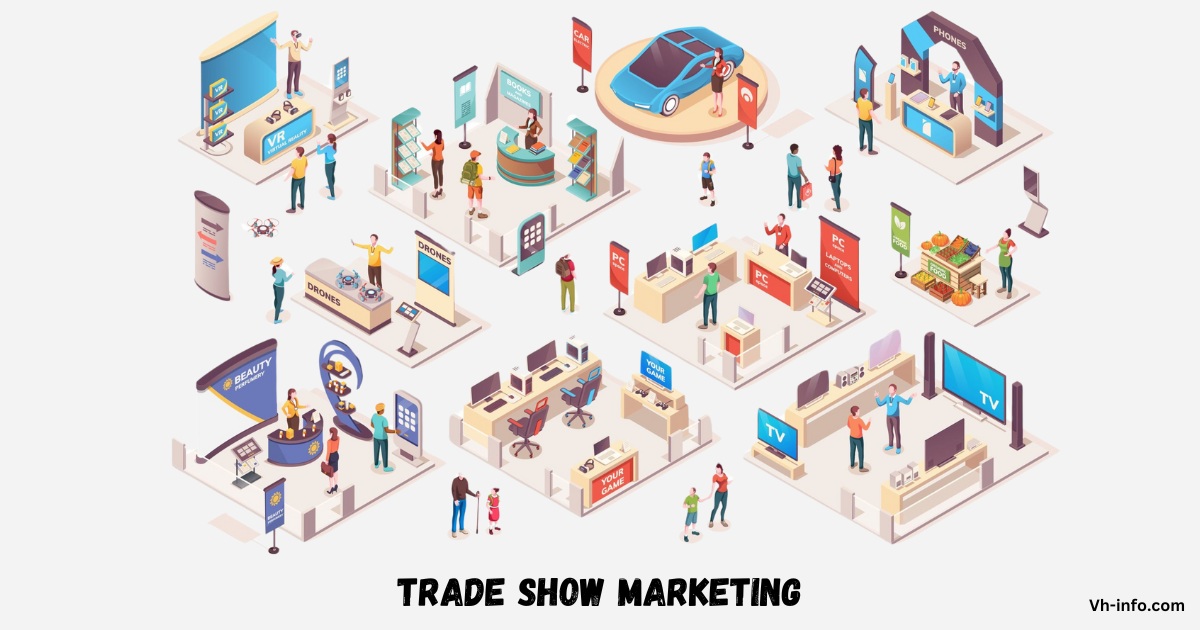Trade show marketing is a powerful way for businesses to show off their products and services, connect with potential clients, and get their brand out there. It’s all about being part of industry-specific events where you can engage with the right people and build relationships that can lead to new leads, customers, and partnerships.
For companies like Vh-info, trade shows are an awesome opportunity to meet potential clients in the software-as-a-service (SaaS) industry. As a link-building service provider, vh-info can use trade shows to show off their expertise and prove how they can boost search engine rankings and drive more traffic to their client’s websites.
In this blog, we’ll dive into the world of trade show marketing, uncovering its benefits, strategies, and best practices to help you become a pro at this marketing tactic. Whether you’re new to trade show marketing or looking to step up your game, this comprehensive guide will give you valuable insights and tips to make the most of your trade show experience.
What is Trade Show Marketing?

Trade show marketing is all about showcasing your products or services at industry-specific events or exhibitions. You create eye-catching displays, hand out promotional materials, and interact with potential customers face-to-face. The main goals are to generate leads, build brand awareness, and establish relationships with clients or partners. It’s a valuable way for businesses to directly engage with their target audience and stand out from the competition.
Why Should You Attend a Trade Show?
Attending a trade show is like hitting multiple birds with one stone for your business. Here’s why you should definitely consider it:
- Boost Brand Visibility: Being at a trade show gets your name out there. When people see you and learn about your company, they’re more likely to remember you when they need your products or services.
- Customer Feedback: You get to hear directly from potential and existing customers. This feedback is like gold because it helps you understand what they like, what they don’t, and how you can improve your offerings.
- Spy on Competitors: Trade shows are like a sneak peek into what your competitors are up to. You can check out their products, strategies, and even find potential partners.
- Discover New Vendors: You might stumble upon vendors offering solutions that could greatly benefit your business. It’s like meeting the right people without having to search extensively.
- Networking Galore: At a trade show, you meet a diverse range of people – vendors, customers, and even competitors. These connections can open up new opportunities for your business.
- Lead Generation: Everyone at a trade show is a potential lead. With the right approach, you can attract people interested in your offerings and grow your customer base.
So, attending a trade show isn’t just about showing up; it’s about seizing countless opportunities to grow and improve your business.
Why Brands Should Go To Trade Shows?
Brands should definitely go to trade shows. They help connect with potential customers and partners. At these events, brands can display products to a varied audience. Joining trade shows lets brands talk, build relationships, and advertise. It’s a good way to get noticed and grow your brand.
The Benefits of Trade Shows for Your Business

Participating in trade shows can be a game-changer for your business, offering a multitude of benefits that can fuel growth and success:
- Brand Exposure: Being at a trade show puts your brand in front of a diverse audience, including potential customers, peers, and partners. This exposure boosts your brand’s visibility and makes it more memorable in the minds of potential customers.
- Product Launches: Trade shows provide the perfect platform to unveil new products or services. With a captive audience eager for industry innovation, you can generate excitement and immediate interest, leading to swift sales.
- Market Insights: Beyond showcasing your products, trade shows offer a chance to gather valuable market insights. Observing competitors, networking, and engaging with attendees helps you stay ahead of emerging trends and customer preferences.
- Immediate Feedback: Interacting directly with attendees allows you to receive instant feedback on your offerings. This helps you make on-the-spot adjustments, ensuring higher customer satisfaction and product refinement.
- Relationship Building: Trade shows are ideal for both meeting potential clients and nurturing existing relationships. Face-to-face interactions foster stronger connections, leading to repeat business and referrals.
- Media Exposure: Trade shows attract media attention, providing opportunities for your business to gain coverage in industry outlets. This boosts your brand’s credibility and increases its reach through publications and news stories.
- Cost-Effective Marketing: Despite initial expenses, trade shows often offer a high return on investment due to their focused audience. Engaging with interested individuals reduces marketing waste and can lead to significant returns.
- Word-of-Mouth Referrals: Positive experiences at trade shows can lead to powerful word-of-mouth referrals, enhancing your business’s reputation and growth potential.
How to Prepare for a Trade Show as an Exhibitor?

Preparing for a trade show as an exhibitor involves several key steps:
- Set Clear Goals: Define your objectives for the trade show, such as generating leads, launching new products, or increasing brand awareness. Clear goals guide your strategy and help measure success.
- Develop a Budget: Allocate funds for booth rental, travel, marketing materials, and other expenses. A well-defined budget ensures resources are used effectively.
- Identify the Best Trade Show: Choose events that align with your target audience and industry focus. Consider factors like location and attendee demographics to maximize impact.
- Create a Marketing Strategy: Promote your participation through advertising, email campaigns, and social media to build anticipation and attract attendees.
- Utilize Social Media: Share sneak peeks and announcements to engage your audience and encourage booth visits. Video promos are effective for generating interest.
- Finalize Vendors: Confirm arrangements with vendors for booth design and technology to ensure everything aligns with your brand’s vision.
- Use Technology: Enhance your booth with interactive displays, check-in apps, live streaming, and event mobile apps to engage visitors and reach a wider audience.
- Create an Eye-Catching Booth: Design a visually appealing booth with captivating graphics, signage, lighting, and layout to stand out from the crowd.
- Plan Engaging Presentations: Develop presentations, product demos, or activities to keep visitors interested and facilitate deeper interactions. Nowadays, one can easily create these presentations with the help of the best AI presentation makers out there.
- Follow Up: Implement a post-show follow-up plan to nurture leads and connections, converting them into customers through personalized emails, calls, or meetings.
Essential Trade Show Marketing Materials
Making a big impact at a trade show means having all the right tools to showcase your brand effectively. Here are the essential trade show marketing materials you’ll need:
- Business Cards: These are your networking lifeline. Make sure they’re professionally designed with all your contact info.
- Social Media Templates: Use pre-designed templates to create eye-catching posts that drum up excitement about your booth on social media.
- Postcards: Catch attention with creative postcards showcasing your offerings, including QR codes to guide attendees to your booth.
- A Stand-out Stand: Invest in a visually appealing booth design that reflects your brand’s personality and draws in visitors.
- Lead Capture App: Streamline lead collection with an app designed to gather contact details and other info from interested attendees.
- Branded Swag: Everyone loves freebies! Offer branded items like pens or tote bags to keep your brand top-of-mind after the event.
- Trade Show Giveaways: Organize giveaways or contests that align with your brand message and leave a lasting impression on attendees.
- Branded Clothing: Dress your team in branded clothing for a professional look and free advertising throughout the event. This makes it easy for attendees to identify your team and approach them for assistance.
With these essentials in hand, you’ll be well-equipped to make the most of your trade show experience and elevate your brand’s presence.
Common Trade Show Planning Mistakes to Avoid
In the whirlwind of trade show preparations, it’s easy to stumble into common pitfalls that can dampen your success. Here are some mistakes to avoid:
- Last-Minute Planning: Don’t leave everything to the eleventh hour. Starting preparations well in advance ensures smoother execution and better options for your booth. Plus, it allows ample time for promotion.
- Ignoring Objectives: Without clear goals, you risk wandering aimlessly. Define specific objectives like generating leads or launching a new product to guide your strategy and measure success.
- Overlooking Budget Management: Poor budgeting can lead to overspending or inadequate allocation of funds, compromising crucial aspects like booth design and marketing materials. Plan your budget wisely to maximize impact within your means.
- Neglecting Pre-Show Marketing: Failing to drum up excitement before the event means fewer visitors to your booth. Utilize various channels like social media, event organizers’ announcements, and email campaigns to spread the word and attract attendees.
- Inadequate Staff Training: Undertrained booth staff can miss opportunities to engage visitors effectively. Ensure your team is well-prepared by practicing interactions, addressing common questions, and familiarizing them with booth technology.
- Neglecting Follow-Up: Letting leads slip through the cracks after the event wastes valuable opportunities. Have a plan in place for post-show follow-up, including thanking visitors for their interest and providing further information to keep them engaged.
Avoiding these common mistakes will help you make the most of your trade show experience and leave a lasting impression on attendees.
How to Measure Trade Show Effectiveness?

Measuring the effectiveness of a trade show is crucial for understanding how well it worked for your business and figuring out how to do better next time. Here are some ways to measure it:
- Lead Generation: Count how many potential customers gave you their contact information during the trade show. These leads show who’s interested in your products or services.
- Sales Conversion: Look at how many of those leads actually turned into sales. This tells you how effective your follow-up efforts were and how much money the trade show brought in.
- Return on Investment (ROI): Figure out if the money you spent on the trade show was worth it. Compare the total costs (like booth rental and travel expenses) to the revenue generated from sales.
- Brand Awareness: Ask attendees if they’re more familiar with your brand after the trade show. This helps you see if being at the trade show made more people aware of your brand.
- Booth Traffic and Engagement: Count how many people visited your booth and see how engaged they were. This tells you if your booth design and activities were appealing.
- Social Media Engagement: Check how much people talked about your brand on social media during the trade show. More mentions, followers, and engagement mean your presence made an impact online.
- Competitive Analysis: Look at how well you did compared to your competitors at the trade show. This helps you see where you stand and where you can improve.
Tips For a Successful Trade Show Experience And Marketing Strategy
To ensure a successful trade show experience and marketing strategy, follow these easy steps:
- Set Clear Goals: Before attending, outline achievable and measurable goals specific to the trade show. Whether it’s boosting sales, collecting leads, or meeting vendors, having clear objectives keeps you focused and motivated.
- Choose the Right Trade Shows: Select trade shows relevant to your industry and target audience. Ensure that the attendees align with your potential customers or partners. For example, if you’re in the kitty litter business, prioritize shows like the Annual Kitty Cat trade show.
- Identify Your Reason for Attending: Determine your primary reason for attending the trade show, which may differ from your goals. It could be showcasing new products, networking, or exploring market trends. Align your participation with your business objectives and timelines.
- Ensure Readiness: Prepare essential materials such as business cards, promotional swag, display boards, product samples, and informational brochures. Be ready to showcase your offerings effectively and engage with attendees.
- Focus on Revenue Generation: Evaluate how your trade show participation will contribute to revenue generation. Consider aspects like website readiness, lead conversion strategies, and post-show follow-up plans to maximize profitability.
- Follow-Up: After the trade show, promptly follow up with leads and contacts gathered. Send personalized emails expressing appreciation for their interest and reinforcing the connections made. Follow-up communication helps maintain engagement and converts leads into customers.
Trade Show Marketing Examples

Here are some examples of trade show marketing strategies:
- Booth Design: An example of effective booth design could be a company that creates an immersive experience for attendees by incorporating interactive displays, engaging signage, and comfortable seating areas. This draws visitors in and encourages them to spend more time at the booth, increasing the likelihood of meaningful interactions.
- Product Demonstrations: A company might showcase its latest products through live demonstrations or hands-on experiences. For instance, a tech company could allow attendees to test out new gadgets or software, providing them with a firsthand experience of the product’s capabilities.
- Giveaways and Contests: Offering enticing giveaways or hosting contests is a popular trade show marketing tactic. For example, a company might raffle off a high-value product or offer branded merchandise as freebies to attract visitors to their booth.
- Educational Workshops or Seminars: Hosting educational workshops or seminars on relevant industry topics can position a company as an authority in its field. For instance, a software company might offer training sessions on how to optimize use of their software, attracting attendees who are interested in learning new skills.
- Networking Events: Organizing networking events such as cocktail parties or luncheons provides an opportunity for attendees to connect with industry peers and experts. This allows companies to foster relationships and expand their professional network.
- Social Media Engagement: Leveraging social media platforms before, during, and after the trade show is crucial for maximizing exposure and engagement. For example, companies can create event-specific hashtags, share behind-the-scenes content, and conduct live Q&A sessions to interact with their audience.
- Email Marketing Campaigns: Sending targeted email campaigns to invite prospects to visit the booth, schedule appointments, or attend special events during the trade show can help drive traffic and generate leads.
- Branded Merchandise: Distributing branded merchandise such as pens, notebooks, or tote bags with the company logo is a cost-effective way to increase brand visibility and leave a lasting impression on attendees.
- Partnerships and Sponsorships: Collaborating with other exhibitors or sponsoring key events within the trade show can enhance visibility and credibility for participating companies.
- Follow-up Strategies: Implementing effective follow-up strategies post-event, such as personalized emails or phone calls to nurture leads and maintain engagement, is essential for converting prospects into customers.
Is Trade Show Marketing Right for You?
Trade show marketing can be highly valuable for your business if your target audience attends industry-specific trade shows and events. It allows you to directly engage with potential customers, gain access to interested parties, build brand awareness, showcase your products or services, and gather valuable insights.
However, it requires careful planning, a well-executed strategy, and a significant investment of time and resources. Evaluate if the potential benefits of gaining new customers align with your marketing goals and budget before committing to a trade show.
FAQ’s:
What is Trade Show Strategy?
A trade show strategy refers to a well-planned approach that outlines a company’s goals, tactics, and activities for maximizing their presence and success at a trade show event. It involves thoughtful planning around booth design, promotions, lead generation, and follow-up to ensure effective use of resources and a strong return on investment. A comprehensive trade show marketing strategy is essential for promoting your participation before, during, and after the event. This could include trade show advertising, email campaigns, social media promotions, and press releases to build anticipation and attract attendees to your booth.
How Can Companies Maximize their ROI through Trade Show Marketing?
Companies can maximize their return on investment (ROI) through trade show marketing by carefully planning their strategy, creating an engaging booth experience, effectively promoting their presence before and during the event, and diligently following up with the leads generated at the trade show.
How Is Social Media Marketing Beneficial For Trade Shows?
Social media marketing is highly beneficial for trade shows as it allows companies to promote their presence before and during the event, engage with attendees in real-time, share updates and interactive content, and continue nurturing relationships with potential leads after the show.
Are Trade Shows Worth It?
Trade shows can be highly worth it for businesses if they have a clear strategy, effectively engage attendees, and diligently follow up on the leads generated. However, as the old saying goes, “You have to spend money to make money.” Attending a trade show is an investment in your company’s future and can lead to potential business benefits. Companies should carefully evaluate the potential return on investment based on their specific goals and target audience.
Are Trade Shows Still Great For Spreading The Word About Your Business?
Yes, trade shows are still an excellent way to spread the word about your business. They provide a unique opportunity to showcase your products or services to a highly targeted audience, build brand awareness, and establish your company as a thought leader in your industry.
Trade show booths also offer valuable networking opportunities, allowing you to connect with potential partners, suppliers, and customers face-to-face – increasing your businesses’ number of leads. In today’s digital age, the personal interactions and hands-on experiences provided by trade shows remain a powerful tool for generating buzz and growing your business.
Conclusion
Trade show marketing is a dynamic and effective strategy for businesses looking to boost their brand visibility, generate leads, and establish themselves as industry leaders.
By carefully planning your approach, creating an engaging booth experience, and leveraging technology and social media, you can maximize the impact of your trade show participation and achieve a strong return on investment.
Remember to set clear goals, choose the right events, and follow up diligently with the leads you generate. With a well-executed trade show marketing strategy, you can unlock new opportunities for growth and success in your industry.

